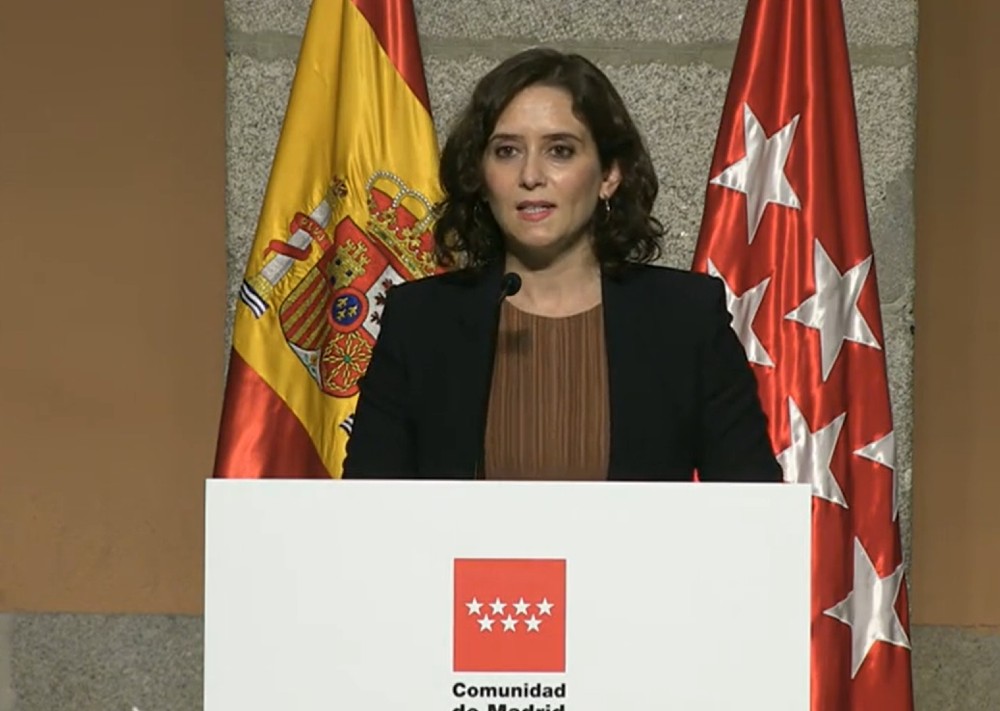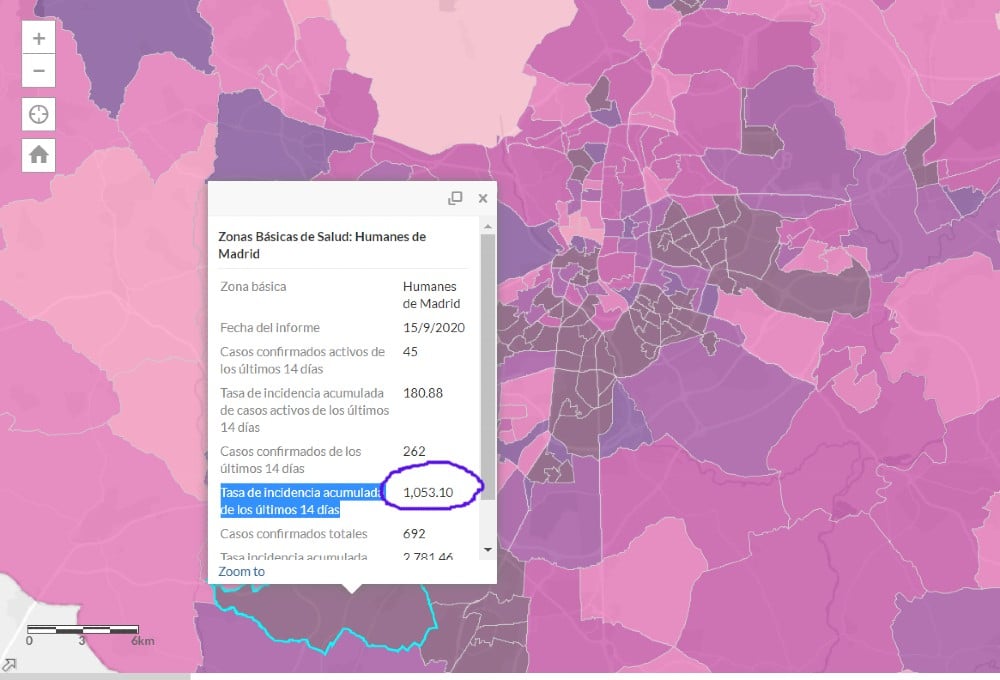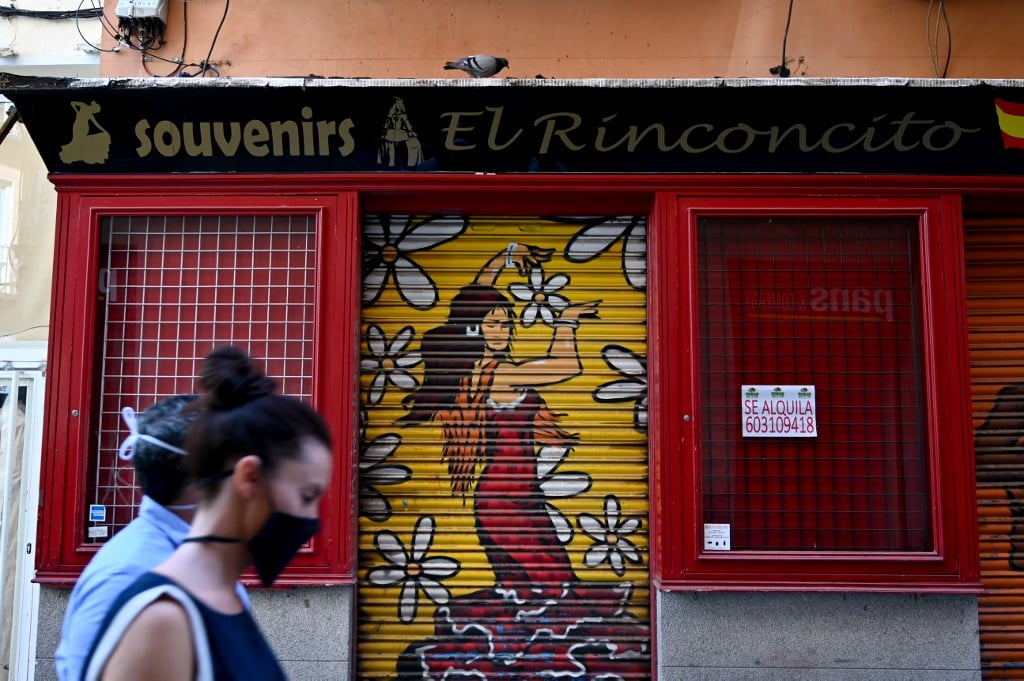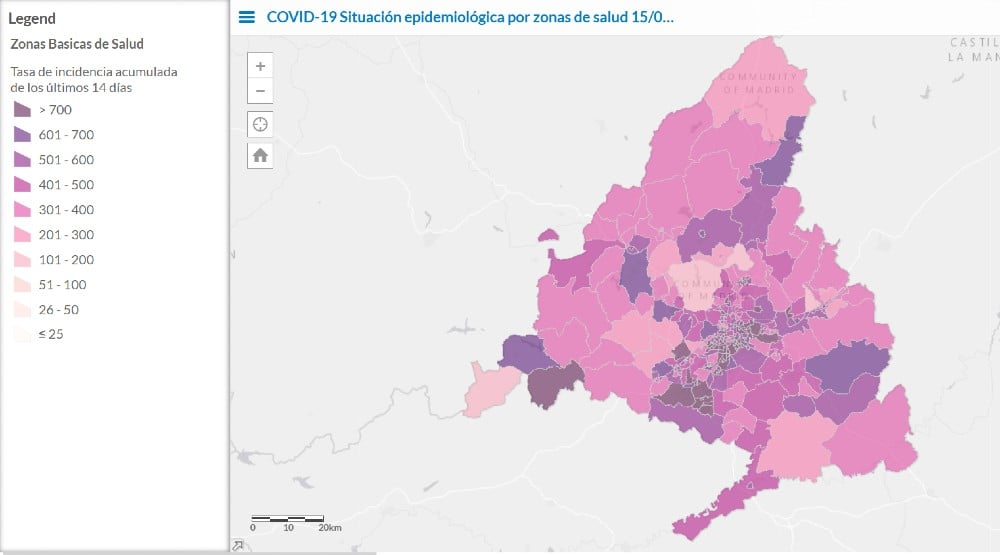MAP: Which areas of Madrid have new restrictions?

Madrid announced new restrictions imposed on the worst hit districts of the region.
The regional government of the Comunidad de Madrid have announced new restrictions on those "Zonas Básicas de Salud" that are the hardest hit by the coronavirus.
LATEST: Madrid region imposes partial lockdown on worst hit zones of capital

Regional leader Isabel Diaz Ayuso announced the measures on Friday afternoon.
But even if you live in Madrid you may be wondering what a Zonas Básicas de Salud is and how you find out which one you live in.
These are designated areas determined by the regional health authorities and you can find out where they are by exploring the map produced by the Madrid government below.
No easy to read map has been produced by authorites as yet but if you locate where you live and examine the data you can find out whether the accumulative incident rate of new cases over the last 14 days is over 1,000 per 100,000 inhabitants.
In Spanish this is called the "Tasa de incidencia acumulada de los últimos 14 días".
If it is then you are likely to be within the "quarantine zone".
Click on the interactive map below and hover over the area you want to check and a box will appear with all the latest epidemiological information.
The deeper the colour purple, the higher the incidence rate.
 The figure circled here in blue is the one you need to look out for and if it is over 1,000 per 100,000 then the "health zone" will likely be a restricted area, although there are five zones which appear to be above the limit but are not included among the confined areas. These are Doctor Trueta, Las Fronteras, Lavapiés, Miguel Servet and Sierra de Guadarrama.
On the other hand three zones (Francia, Las Margaritas y Sánchez Morate) that have been added to the restricted list have an incidence rate just below the 1000 cases per 100,000 people threshold.
You can also look at these interactive maps produced by Spanish newspaper, El Diario where the first map clearly shows in red, the areas with confinement perimetres.
The figure circled here in blue is the one you need to look out for and if it is over 1,000 per 100,000 then the "health zone" will likely be a restricted area, although there are five zones which appear to be above the limit but are not included among the confined areas. These are Doctor Trueta, Las Fronteras, Lavapiés, Miguel Servet and Sierra de Guadarrama.
On the other hand three zones (Francia, Las Margaritas y Sánchez Morate) that have been added to the restricted list have an incidence rate just below the 1000 cases per 100,000 people threshold.
You can also look at these interactive maps produced by Spanish newspaper, El Diario where the first map clearly shows in red, the areas with confinement perimetres.
En este mapa interactivo puedes comparar las zonas básicas de salud con restricciones, así como su incidencia acumulada en los últimos 14 días, el número de casos diagnosticados y el número de casos por cada 100.000 habitantes https://t.co/7pSXLEMxDK pic.twitter.com/pUTMvULGIF
— elDiario.es (@eldiarioes) September 18, 2020
If you find lists easier to navigate than maps and are confident you know which health zone you fall under then here is a list of those areas that have the new restrictions imposed:
Carabanchel: Puerta Bonita, Vista Alegre and Guayaba.
Usera: Almendrales, Las Calesas, Zofío, Orcasur and San Fermín.
Villaverde: San Andrés, San Cristóbal, El Espinillo and Los Rosales.
Villa de Vallecas
Puente de Vallecas: Entrevías, Martínez de la Riva, San Diego, Numancia, Peña Prieta, Pozo del Tío Raimundo, Ángela Uriarte, Alcalá de Guadaira and Federica Montseny.
Ciudad Lineal: Doctor Cirajas, Ghandi, Daroca and La Elipa.
Fuenlabrada: Alicante, Cuzco and Francia.
Parla: San Blas and Isabel II.
Getafe: Las Margaritas and Sánchez Morate;
San Sebastián de los Reyes: Reyes Católicos.
Alcobendas: Chopera and Miraflores.
And the municipalities of Humanes de Madrid and Moraleja de Enmedio.

What are the new restrictions?
If you live within one of the restricted "basic health zones" then you will as of Monday only be allowed to leave the zone to go to work, seek medical care or take their children to school or because of a "force majuere".
All bars and restaurants will have to reduce their capacity by 50 percent, parks and public spaces will be closed.
Residents of the areas affected will be allowed to move around freely inside their zone but no one from outside will be allowed in.
Meetings across the whole of the Madrid region have, from Monday, been reduced to six people down from the current 10.
How long will they last?
Restrictions would be in place from Monday, said Regional President Isabel Diaz Ayuso who added that they would be in place for at least 14 days.
Comments
See Also
The regional government of the Comunidad de Madrid have announced new restrictions on those "Zonas Básicas de Salud" that are the hardest hit by the coronavirus.
LATEST: Madrid region imposes partial lockdown on worst hit zones of capital

Regional leader Isabel Diaz Ayuso announced the measures on Friday afternoon.
But even if you live in Madrid you may be wondering what a Zonas Básicas de Salud is and how you find out which one you live in.
These are designated areas determined by the regional health authorities and you can find out where they are by exploring the map produced by the Madrid government below.
No easy to read map has been produced by authorites as yet but if you locate where you live and examine the data you can find out whether the accumulative incident rate of new cases over the last 14 days is over 1,000 per 100,000 inhabitants.

En este mapa interactivo puedes comparar las zonas básicas de salud con restricciones, así como su incidencia acumulada en los últimos 14 días, el número de casos diagnosticados y el número de casos por cada 100.000 habitantes https://t.co/7pSXLEMxDK pic.twitter.com/pUTMvULGIF
— elDiario.es (@eldiarioes) September 18, 2020
Carabanchel: Puerta Bonita, Vista Alegre and Guayaba.
Usera: Almendrales, Las Calesas, Zofío, Orcasur and San Fermín.
Villaverde: San Andrés, San Cristóbal, El Espinillo and Los Rosales.
Villa de Vallecas
Puente de Vallecas: Entrevías, Martínez de la Riva, San Diego, Numancia, Peña Prieta, Pozo del Tío Raimundo, Ángela Uriarte, Alcalá de Guadaira and Federica Montseny.
Ciudad Lineal: Doctor Cirajas, Ghandi, Daroca and La Elipa.
Fuenlabrada: Alicante, Cuzco and Francia.
Parla: San Blas and Isabel II.
Getafe: Las Margaritas and Sánchez Morate;
San Sebastián de los Reyes: Reyes Católicos.
Alcobendas: Chopera and Miraflores.
And the municipalities of Humanes de Madrid and Moraleja de Enmedio.

What are the new restrictions?
If you live within one of the restricted "basic health zones" then you will as of Monday only be allowed to leave the zone to go to work, seek medical care or take their children to school or because of a "force majuere".
All bars and restaurants will have to reduce their capacity by 50 percent, parks and public spaces will be closed.
Residents of the areas affected will be allowed to move around freely inside their zone but no one from outside will be allowed in.
Meetings across the whole of the Madrid region have, from Monday, been reduced to six people down from the current 10.
How long will they last?
Restrictions would be in place from Monday, said Regional President Isabel Diaz Ayuso who added that they would be in place for at least 14 days.

Join the conversation in our comments section below. Share your own views and experience and if you have a question or suggestion for our journalists then email us at [email protected].
Please keep comments civil, constructive and on topic – and make sure to read our terms of use before getting involved.
Please log in here to leave a comment.